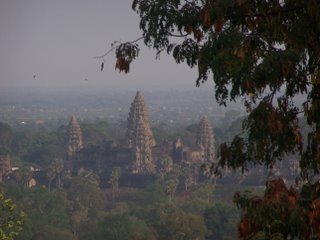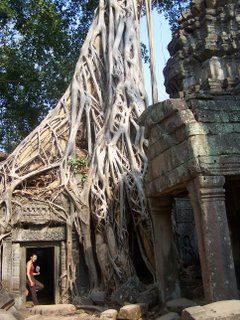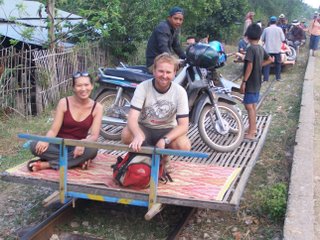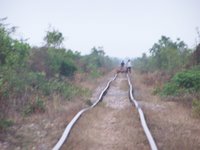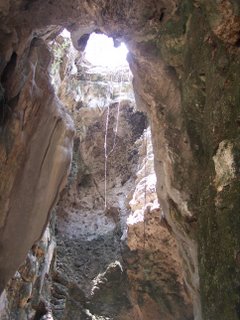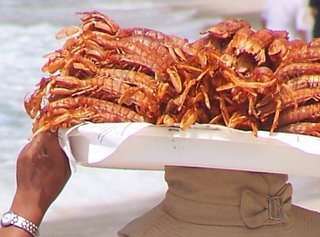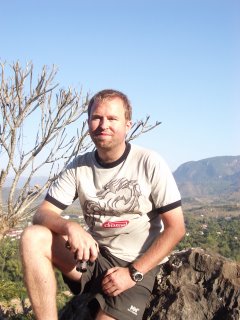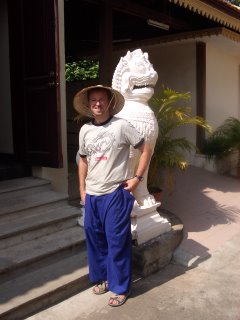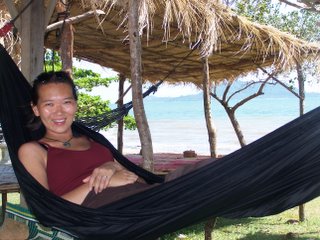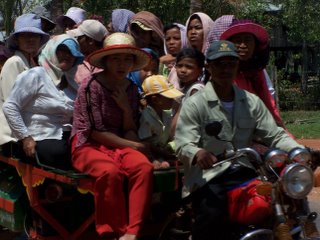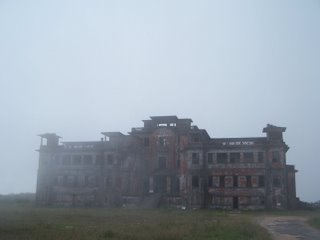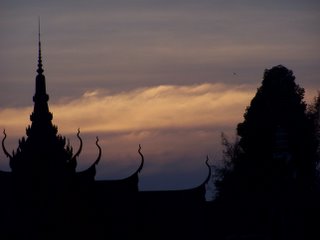Malaysia
Insert photo of Michael, Diana and girls here - perhaps standing outside their plush residence in KL.
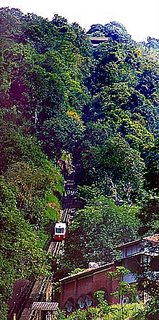
Penang Hill railway (photo off the web).
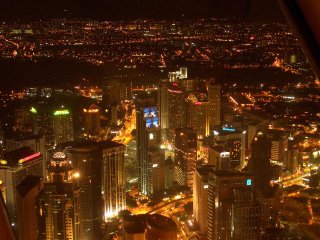
View from floor 41 Petronus Towers at night (photo off the web)
Other photos to follow - probably .....
It is a strict requirement that a passport must by valid for at least six months from the proposed entry date into Malaysia. Sam had five months and three weeks remaining, and as we queued up at passport control in Kuala Lumpur we were a little nervous (having looked again at the Malaysian immigration page and followed the link for deportation).
Since 1971 the Government introduced minimum quotas for Malays in business, education and the civil service. This was an acknowledgement that Malays are somewhat lackluster in the work place (the most prominent champion of Malay rights - ex PM Mahathir Mohamad - ended his 22 years as premier acknowledging that rather than develop a work ethic, many Malays had simply developed a sense of entitlement).
Possibly due to the significant "positive" discrimination, everyone seated behind the desks of passport control appeared to be Malay. Whether or not this meant they were work shy and ineffective we cared not at all once Sam had received the stamp in her passport and skipped (suspiciously) all the way to customs.
Finding a definition for a "Malay" (other than passing comment on their slack motivation in the workplace) is harder than it seems. One interpretation (mine) is that a "Malay" women is someone observing Hijab (e.g. Muslim, and wearing long full dresses and a head covering), and a "Malay" man is a Malaysian who isn't of Chinese, or Indian appearance.
My generalised definitions are because a) Malays are Muslim, and b) whilst under British rule (1796 to 1957) millions of Chinese came to Malaya to start businesses and work in tin mines. Tamils were brought over to work in the rubber plantations, and Punjabis and Sikhs acted as police officers and worked on the railways. Today therefore twenty four percent of Malaysians are of Chinese descent (the wealthiest community with the most economic power) and seven percent are Indian. (To this cocktail indigenous tribes people make up eleven percent and the latest immigrant workforce a further eight percent).
Only 50% of Malaysia is therefore made up of "Malays" - but as this still represents the majority it is they who hold political sway.
Insulating the Muslim population from harmful foreign influences (kissing on the telly etc) is a clear government policy and Malaysia has some of the toughest censorship laws in the world. In a recent case, for example, a DJ made references to an American couple living together outside of marriage, also of a group of teenagers getting extremely drunk - both on a popular day time show and both causing scandal. Later, after her resultant dismissal, we went to stay with her for a couple of weeks.
Diana is a very good friend of Sam's from sixteen years past. Her husband, Michael is an Aussie. Anna, their daughter, is aged two.
(nb the causes of the scandal above are completely made up - I've forgotten why Diana was prompted to leave (despite being really popular on the radio) ... I'll ask her again and amend in due course).
From the onset Anna set about explaining (in the best way she knew how) why her age group is called terrible. For example, when she was keen to play with something but wasn't allowed to, she'd cry like her life depended on it. When she enjoyed something (like being lifted overhead) but you were just too tired for the ninety ninth repetition, she'd do some very unreasonable and disproportionate seeming screaming. When she's happily sitting watching some tedious kids show (Barney) on telly - but suddenly realises it's been a while since she's seen mum, and therefore everyone is being treated better than her and the world must despise her - the peace (relative - due to Barney) would end faster than a punch in the ear drums.
Life at Diana and Michael's was to be an education for both Sam and myself.
I believe I passed my first lesson - when Anna wanted to play with the shiny meat cleaver I was using to chop potatoes I almost buckled under the tears and screams. At the last minute though I reasoned that even if she thought her life depended on having it, probably it was the other way around.
The scenario for day two was that whenever two factors meet - a writing implement and any domestic substitute for canvas - Anna had a large penchant for experimental art work. Enter Anna with, from thin air, a large marker pen in her hands and a happy winning grin.
I failed the lesson, but from the experience I've now learnt the correct actions could be 1) stern words explaining the marker pen is not a toy, 2) firm removal of the pen (from Anna's now conceding hands) 3) a fun distractant along similar, but less destructive, lines to scrawling all over the wall with permanent ink.
My errors were plentiful - wrestling Anna for the pen and mumbling something about 'not for you' immediately fed the 'must have at all costs' furnace. When eventually getting hold of the pen, and now being confronted by a distraught bawling Anna, I tried to make the pen disappear (somehow hoping that would make the problem (Anna?) disappear). On the telly I saw Paul Daniels wave his hands around and release the paper (nb makes no noise when it lands) over the head of the star struck participant at just the right time. Sadly Anna wasn't greatly star struck, the pen was released at about Anna eye level and it landed with a bang. As she turned to pick it up and once again run furiously to mum, this particular class ended in what was to become a familiar fashion.
(Later on I watched as Diana pretended to throw the 'dangerous' thing over Anna's head (but then pocket it while Anna was looking over her shoulder) - if only I'd appreciated the 'throwing over the head' trick was now passé for a two year old)!
Other obvious differences between the teacher (Diana) and the student (me) were that immediately after making the 'dangerous' thing vanish, Diana could replace it by something suitable but fluffy - and the hairline balance between sweet, happy and playful Anna to monster Anna from the swamp would somehow remain checked.
Other lessons learnt - start as you mean to go on (if they become used to something early on it's a nightmare to reverse) and develop a taste for Japanese minimalist design (things on shelves (telephones, DVDs, DVD players etc) become things bashed on the floor as hard as possible (in the name of playing, experimentation or reaction seeking)). A final lesson maybe to become very philosophical if, as well as a terrible two in the family, there's also an eight month old called Emma.
Like Anna, Emma was very cute. Unlike Anna she'd yet to develop a passion for all things she can't have - she tries to reach them, but shrugs as they all slide magically away from her grasp (if she does reach something - it goes in the mouth). Emma only cried when she was tired or hungry, or after two minutes of being held by me. When she was tired, hungry, and I'd just put her down after a couple of minutes it would take everything Sam and I could do to keep her (alias wriggly bottom) amused. Occasionally we'd succeed for a while in keeping her bemused, but once our antics started to scare her she was returned to owner. We'd slump back in our seats and scowl at her for looking so peaceful in the arms of mum. (Sam's maternal abilities did come to the fore though - and Emma was far more peaceful in her arms than mine).
On a few occasions Emma would be peacefully asleep, and Anna would be contentedly playing - and then Ava, aged five (and 363 days on the day we left) would return from school. After Ava accidentally removes Anna's toy and unwittingly chucks it at Emma who wakes up and feels a little peckish ... the resulting cacophony was just another day in the life of Diana.
Spending time in Diana and Michael's house was a pleasure - however it may sound. Their house was very large and comfortable and they were very hospitable and good company. We did need a new passport for Sam though - as we didn't fancy repeat nerves at the Thai border (Thais also want to convert a ten year passport to a nine and a half year one). To ensure we're not totally relaxed whilst leaving Malaysia we decided to believe the British Embassies advice that we didn't need a new Malaysian entry stamp in the new passport.
The British embassy (recently complete with an inner compound and two new layers of barbed wire) was located within base jumping distance from the twin Petronas (Malaysian oil company) towers - and we made every effort to take the tourist tour up to the 41st floor and the skyway bridge .... Every effort that is accept getting out of bed at 7am in order to be allocated one of the poxy 800 available tickets allocated each day.
The Petronas towers are a definite landmark to Kuala Lumpur, at 452 metres they're currently the second tallest buildings in the world (after Taipei 101 in Taiwan (509 metres)). Taipei 101 has 101 storeys and it's the tallest possibly because the Chinese appear not to like building over 88 storeys high (8 is good fortune - with 88, nothing can go wrong). The Petronas towers must have higher ceilings than the Jin Mao Building in Shanghai (5th largest) and the 'Two International Finance Centre' in Hong Kong (6th largest) which both also have 88 storeys). The Chinese influence doesn't extend to the architecture though, which is somehow supposed to represent the main principles of Islam - unity, harmony, stability and rationality. (Not principles western infidels naturally associate with Islam in recent times).
Some more universally interesting facts - Kuala Lumpur also has a tall tower (e.g. no storeys) - the Menara Kuala Lumpur is the 5th highest in the world (no. 1 is the CN Tower in Toronto at 553 metres). The tallest mast was 646 metres (in Poland) but it collapsed and now the tallest is 629 metres in North Dakota. The highest structure is the Petronius (no relation to Petronas) Oil Platform which is 610m - though as most of it is underwater it doesn't count as freestanding.
So - after just a little shy of two weeks we, somewhat reluctantly, left KL and caught a very luxurious (and not to forget - cheap) bus to the North West of Malaysia to Penang.
In Penang we were happy to see they have a tall building ... the Komtar Centre has 65 floors and at 232 metres is the 138th tallest in the world (1 Canada Square in London's docklands is 237 metres and has 50 storeys). We were able to get a ticket to the 60th floor here, where we enjoyed the air conditioning, tutted at how they kept the outside of the windows so dirty, looked at Georgetown below (the capital of Penang and second largest town in Malaysia), and then left.
Like all big towns in Malaysia (it seems) Georgetown has a China Town (here about 90% of the town) and a Little India. Squeezed into small spaces there were some mosques and a bit of Hassan wailing to be heard.
The official religion in Malaysia is Muslim - though with such a disparate population then also featuring are Buddhists, Daoists, Hindus, Christians, Sikhs and some Shamanism. The official language is Bahasa Melayu, though English is compulsory in schools and seems to be the common link language between the different races (who speak Cantonese, Mandarin, Hokkien, Hakka, Hainan and Foochow (dialects of Chinese), Tamil, Telugu, Malayalam, Panjabi, Thai and several indigenous languages).
We mostly settled for English, and the fact it's spoken by almost everyone made travel very straight forward. Pitted against this though, is that Malaysia is well on the way to becoming a fully industrialised nation (target 2020). This means the public transport is rubbish ... everyone has a car and cheap and easy ways to get around town don't exist (the taxis are a (relative) rip off and they don't bargain (or use meters)), local buses take ages to arrive, are crowded, tour all the local housing estates, and spend a lot of time in traffic jams. We'd think we were home but for the addition of thirty five degrees of heat.
The long distance buses however seemed good. This is based on the only long distance bus we took in Malaysia. Our journey to Penang was for 369km up the west coast (the Malay peninsula stretches from north to south for about 800km). At one point on the journey we were delighted to find that our bus was making it's way up a small incline. Further to this there were trees on both sides (only 5% of the original 97% of the country’s forestation remains (Malaysia is one of the worlds biggest timber exporters)) ....... with these circumstances we were both immediately able to visualise exactly what the Cameron Highlands must be like!
This was fortunate because we'd decided with such a short amount of holiday remaining that we were justified in not doing anything that sounded like hard work. Examples were our watching the Formula 1 on the telly while it was happening only half an hour away from us in KL, or visiting the Cameron Highlands (tucked away serenely amidst the clouds 1,829 metres and premier hilltop holiday spot (for anyone with a car (or motivation))).
Further into our Penang journey, the bus passed over a suspended bridge, again there were trees surrounding us - though they looked older - and there was a small child howling from, it seemed, all around us. This bought to mind exactly what it must be like if we'd been bothered to visit the Taman Negara National Park.
Taman Negara is Malaysia's premier National Park, it covers 4343 square kilometers and, at 130 million years old, it's the oldest rain forest in the world. It also has the longest canopy walkway in the world which spans 460 meters and is suspended 40 meters off the ground. The cries of the Long Tail Macaque monkeys are all around. Uncanny, and lucky for us, that conditions were such that we'd felt we'd experienced it all from our lazy option luxury bus to Penang.
So we could have been more energetic in Malaysia, and seen more on Peninsula Malaysia. (Malaysia was formed in 1963 when the former British colonies of Singapore and the (now) East Malaysian states of Sabah and Sarawak on the northern coast of Borneo joined the Federation of Malaya (the ex-British ruled territories on the Malay Peninsula).
Singapore left the Federation in 1965 to become independent. About 25% (my guesstimate) of Borneo remains Malaysian (Brunei is also here, as is Kalimantan (part of Indonesia)). Borneo is the third largest island in the world (Britain is the ninth largest island).
The Malaysian states of Borneo apparently are a key tourist destination, offering excellent beaches, brilliant scenery and spectacular wildlife ... unfortunately our bus trip to Penang couldn't reproduce this for us.
We did see some other highlights in Penang. Billed as perhaps the only temple of its kind in the world, Penang's Snake Temple is filled with the smoke of burning incense and a variety of pit vipers (made docile supposedly by the incense (and also de-venomed)). We caught the local bus there (forty minutes wait, one hour journey, 15km away), and then we caught the next bus back. We did see four snakes - though the 'made docile by incense' may be a line they use to cover up why they looked to be either dead or made of plastic.
The next day we waited thirty minutes to travel for forty minutes (8kms) to wait for thirty minutes to catch the Penang Hill chain railway. It takes half an hour to reach the top (after one stop and change of trains). It takes three minutes at the top to appreciate it's not a great highlight, but then it took a further thirty minutes queueing to catch the train back down (which this time took fifty minutes to reach the bottom - being stuck, as we were, for twenty minutes in the overcrowded, overheating cars listening to all the nice children screaming).
We're probably not giving Malaysia it's fair chance - with our now only having three weeks till we're standing at Heathrow looking helpless, forlorn and overwhelmed in a cold, wet, crowded, expensive and bustling materialistic world we're already starting to re-adjust to the embittered cynical attitudes of eleven months ago.
So to keep the spirits up, I got another haircut. The main shopping centre (the Malaysians love shopping centres - probably more for the fact they're air conditioned than for shopping) had a plethora of hairdressers. They were salons, stylists and boutiques - and although the basic haircut cost just over a pound, I didn't find myself drawn to the gentlemen proffering the scissors (as much as they appeared drawn to gentlemen per se).
Instead we left the lovees in their air conditioned loveliness and speed walked (in the heat of the day) back to Chinatown and into a genuine down-to-earth Indian barbers. Here the haircut was twice the price, and after they removed the polyester sheet and towel from around my shoulders everyone was amazed to discover I'd lost 50% of my body weight in excess perspiration.
The timing of the haircut was partially so I could look nice and smart for dinner that night with Sam's Aunty Yong (actually the sister of Sam's Aunt-in-law). It's always much better to be shown around by locals - and we didn't pass up on the opportunity to be taken around the hawker food stands (e.g. food cooked on the roadside). A google search on 'penang' 'food' and 'heaven' brings up 129,000 hits, it's famous for the variety and quality of it's food - not least the hawker food. The only limit we placed on the food was no seafood. We stressed no sea food on the phone the night before, in the car Sam explained her allergies to seafood, and by the stalls we reiterated no seafood.
Penang is most famous for the quality and freshness of the seafood. The first dish placed in front of us was a prawn, crab and oyster noodle soup. Next came a dry fat noodle dish with prawns, followed by a dish of pigs intestines and tofu.
In fact the dry fat noodles were delicious, as was the last dish which was fish in a spicy sauce (everything is spicy in Malaysia - we wouldn't have been surprised if they laced their soft drinks with chillies).
It was very nice of Yong (and her husband) to meet us and dine us. After the food they drove us to their home briefly, then we went on a small tour of the island before being dropped back at our guest house.
The Malaysian people did seem very friendly, frequently people would wish us well whilst we were in their country (without seemingly wanting us to buy anything). Also we have heard the Cameron Highlands, Taman Negara and other tourist spots are good. Our overall impression though is that it's not a natural backpackers country (we took less than ten photos during our stay in Malaysia). Today is our first day back in Thailand (in Krabi) - it's cheaper, easier to travel and incredibly photogenic. It still doesn't detract from our only now having eighteen days remaining.

